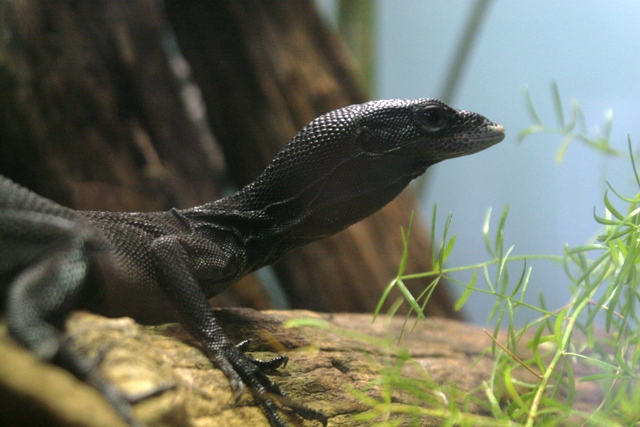|
| Query: Black tree monitor | Result: 1st of 15 | |
Black Tree Monitor (Varanus beccarii) - Wiki
| Subject: | Black Tree Monitor (Varanus beccarii) - Wiki
| |

| Resolution: 640x427
File Size: 140007 Bytes
Date: 2005:12:27 12:09:53
Camera: Canon EOS 20D (Canon)
F number: f/5.0
Exposure: 1/100 sec
Focal Length: 77/1
Upload Date: 2007:09:20 20:03:08
|
Black tree monitor
From Wikipedia, the free encyclopedia
[Photo] Black Tree Monitor, St. Louis Zoo, 12/27/2005, Robert Lawton (http://en.wikipedia.org/wiki/User:Rklawton). | Permission is granted to copy, distribute and/or modify this document under the terms of the GNU Free Documentation License, Version 1.2 or any later version published by the Free Software Foundation; with no Invariant Sections, no Front-Cover Texts, and no Back-Cover Texts. A copy of the license is included in the section entitled "GNU Free Documentation License". |
The Black Tree Monitor (Varanus beccarii) is a relatively small member of the Varanidae family.
Physical Description
Hatchlings and juveniles are a dark grey in colour, with regular rows of bright yellow-green dots which are particularly noticeable on the back. As they achieve adulthood they turn completely black, losing the colourful dots. Fully grown specimens reach 3 to 4 feet in length, with the males slightly larger than the females.
Unique Characteristics
The Black Tree Monitor is generally well adapted for living in trees. Its tail is particularly long, sometimes two-thirds of the overall body length, and is used in a prehensile manner to stabilize the animal in the branches. In fact, the tail is used solely for this purpose, as the animal does not evince the defensive tail-lashing behaviour seen in other monitor species. The Black Tree Monitor’s feet sport large claws and adhesive soles, which help it to maintain grip in the trees. It also has unusually long teeth for a monitor of its size, which may help it to hold on to prey it catches in the canopy.
Food Web
Black Tree Monitors are carnivorous, taking a range of prey items. Mostly commonly eaten are insects, smaller lizards, and small mammals such as shrews. They may also take scorpions, eggs, and nestlings. They are themselves predated by larger lizards and snakes. Foxes, which were introduced to the region, are an unnatural predator of the Black Tree Monitor. They are also hunted by humans.
Geographical Distribution and Habitat
The species is native to the forest of the Aru islands of Papua New Guinea, where it is known locally as Waweyaro.
Conservation
Varanus beccarii is not currently on the IUCN red list. However considering its restricted range, it is vulnerable to any loss of habitat in the region. It is also popular in the pet trade, with most specimens being wild-caught.
http://en.wikipedia.org/wiki/Black_tree_monitor
| The text in this page is based on the copyrighted Wikipedia article shown in above URL. It is used under the GNU Free Documentation License. You may redistribute it, verbatim or modified, providing that you comply with the terms of the GFDL. |
|
^o^
Animal Pictures Archive for smart phones
^o^
|
|

